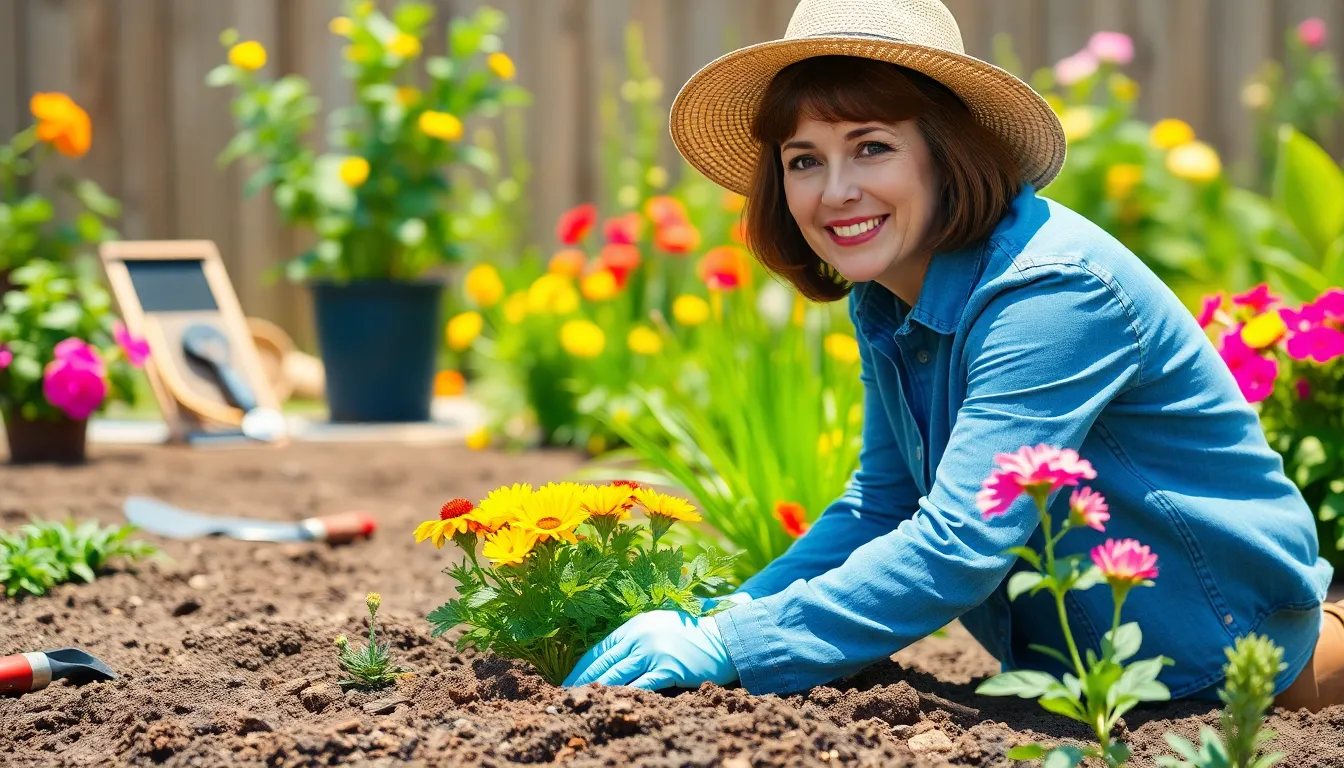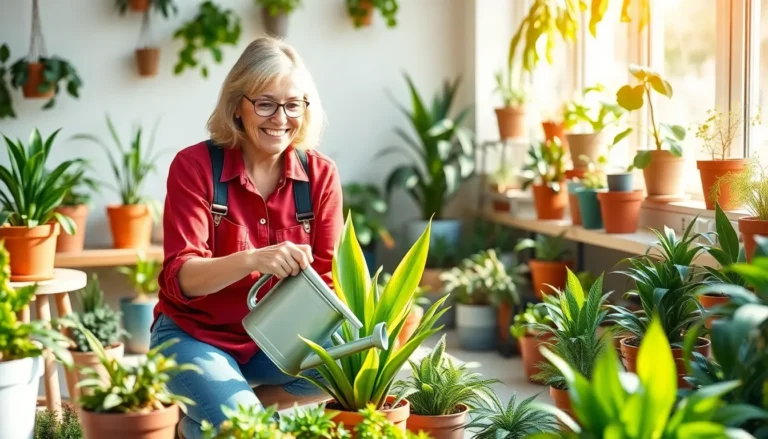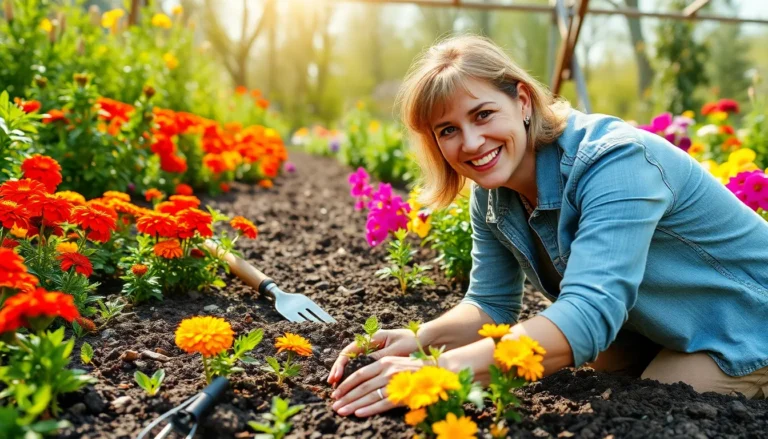Imagine stepping into your backyard and being greeted by a vibrant oasis of fresh herbs, colorful flowers, and maybe even a tomato plant that could rival your neighbor’s prized pumpkins. Home gardening isn’t just a hobby; it’s a delightful way to reconnect with nature and impress your friends with your green thumb. Plus, who wouldn’t want to pluck their own salad ingredients right outside their door?
Home Gardening Tips
Choose the right location for your garden. Opt for a spot that receives at least six hours of sunlight daily. Plants thrive in bright conditions, enhancing growth and flavor.
Select quality soil for planting. Using organic compost and well-aerated soil provides essential nutrients. Healthy soil translates directly into vigorous plant development.
Water carefully to avoid over-saturation. Plants require moisture but suffer from excess watering. Monitor soil moisture regularly to ensure optimal hydration.
Utilize mulching techniques. Applying mulch around plants retains soil moisture, suppresses weeds, and regulates temperature. Organic materials like straw or wood chips serve as excellent mulch options.
Space plants adequately to allow for proper air circulation. Crowded plants compete for resources, which can hinder growth. Each plant type has specific spacing needs that enhance their health.
Rotate crops each season. Changing plant locations prevents soil nutrient depletion and reduces pest issues. Practicing crop rotation maintains soil vitality and maximizes yield.
Monitor for pests consistently. Early detection of pests facilitates effective management. Employ natural pest control methods, like beneficial insects, to limit harmful effects.
Prune regularly to promote healthy growth. Trimming dead or diseased branches enhances air circulation and encourages new growth. Each plant responds well to targeted pruning techniques.
Collect seeds from mature plants to preserve plant varieties. This practice not only creates a sustainable garden but also allows for the customization of future plant selections. Seed saving fosters self-sufficiency in gardening.
Experiment with companion planting. Some plants benefit from being near others, improving growth and repelling pests. By grouping companion plants strategically, gardeners can create vibrant and productive ecosystems.
Choosing the Right Plants

Selecting the right plants is crucial for a flourishing home garden. Understanding seasonal changes and local climate ensures successful growth.
Seasonal Considerations
Different seasons influence plant selection. Spring and summer offer opportunities for growing herbs, vegetables, and flowering plants. Cool-season crops, such as leafy greens, thrive in autumn and early spring. Warm-weather plants, including tomatoes and peppers, flourish when temperatures rise. Timing plantings around frost dates contributes to maximizing yields and reduces the risk of loss. Awareness of seasonal changes can guide gardeners in scheduling their plantings effectively.
Planting Zones
Planting zones determine which plants thrive in specific regions. The USDA Plant Hardiness Zone Map designates areas based on average annual minimum temperatures. For example, Zone 5 experiences winter temperatures between -10°F to -20°F, suitable for cold-tolerant plants like kale and peonies. Zone 9, with milder winters, accommodates tropical plants such as hibiscus and citrus varieties. Researching local planting zones ensures correct plant choices and promotes healthy growth in home gardens.
Essential Gardening Tools
Every gardener benefits from having the right tools to enhance their gardening experience. Effective tools simplify tasks and contribute to a thriving garden.
Basic Tools Every Gardener Needs
Shovels and spades serve as the backbone of any gardening toolkit. These tools assist in digging, turning soil, and planting. Rakes help clear debris and level the ground, ensuring a smooth planting surface. Pruning shears play a critical role in maintaining plant health by removing dead or overgrown branches. Gloves protect hands from thorns and dirt, allowing for comfortable gardening. Watering cans or hoses ensure plants receive adequate moisture, preventing drought stress.
Optional Tools for Advanced Gardening
Gardeners seeking to elevate their gardening game might consider additional tools. A tiller improves soil structure by breaking up compacted earth, promoting better aeration. Planting mats simplify seed organization during sowing. A compost bin facilitates the recycling of kitchen scraps and yard waste into nutrient-rich soil amendments. Soil testers provide valuable insights into pH and nutrient levels, guiding fertilization efforts. Greenhouses create controlled environments for germinating plants and extending growing seasons, particularly beneficial in colder climates.
Soil Preparation and Maintenance
Proper soil preparation and maintenance is crucial for a successful home garden. Healthy soil enhances plant growth, improves yields, and supports biodiversity.
Testing Soil Quality
Testing soil quality provides essential insights about nutrient levels. A pH test determines acidity or alkalinity, affecting nutrient availability for plants. Soil testing kits, available at garden centers, enable gardeners to assess nutrients like nitrogen, phosphorus, and potassium. Lab analysis offers more detailed results if gardeners require precise information. Understanding soil quality helps in making informed decisions about amendments and plant selection.
Organic Amendments
Organic amendments significantly enrich soil structure and fertility. Compost, made from decomposed organic matter, adds essential nutrients and enhances water retention. Manure, another potent amendment, provides vital nutrients while promoting microbial activity. Gardeners can use shredded leaves or grass clippings as natural mulches to conserve moisture. Additionally, incorporating cover crops, like clover or vetch, improves soil health during off-seasons. Regular application of these organic amendments maintains a balanced ecosystem and supports sustainable gardening practices.
Watering Techniques
Effective watering practices are crucial for plant health. Proper techniques prevent water waste and ensure plants receive necessary hydration.
Efficient Watering Methods
Drip irrigation systems provide a targeted approach, delivering water directly to the roots. Soaking hoses also promote efficient watering by slowly releasing moisture into the soil. Watering in the early morning reduces evaporation, allowing plants to absorb moisture before the heat of the day. Rainwater collection systems offer an eco-friendly alternative, providing plants with natural hydration while conserving resources. Using mulch around plants retains soil moisture and minimizes the frequency of watering.
Signs of Over- or Under-Watering
Wilting leaves signal a potential issue with watering practices. Droopy foliage may indicate both over- or under-watering, depending on the severity of the condition. Yellowing leaves often occur as a sign of over-watering, while brown edges suggest under-watering has taken place. Soil checks provide valuable insight; dry soil indicates a lack of moisture, while overly saturated soil suggests excessive watering. Root rot develops from prolonged over-watering, leading to plant decline. Adjusting watering frequency based on these signs supports healthier plants.
Pest Control Strategies
Maintaining a healthy garden involves effectively managing pests without harmful chemicals. Implementing integrated pest management techniques ensures that plants thrive.
Natural Pest Remedies
Utilizing natural remedies can effectively deter pests. Neem oil acts as a powerful insect repellent, disrupting the life cycle of many pests. Additionally, garlic spray offers a strong scent that repels unwanted insects. Applying diatomaceous earth creates a barrier, dehydrating and eliminating soft-bodied pests. Companion planting, such as marigolds alongside vegetables, attracts beneficial insects and suppresses pest populations. Introducing ladybugs or lacewings also provides natural pest control, as these insects feed on aphids and mites.
Preventative Measures
Taking preventive steps protects gardens from pest invasions. Keeping plants healthy through proper watering and fertilization strengthens their defenses against pests. Regularly inspecting plants for signs of infestation allows gardeners to address issues early. Practicing crop rotation prevents pests from establishing themselves in one location. Maintaining garden cleanliness, such as removing debris and dead plants, reduces habitat for pests. Implementing physical barriers, like row covers, protects delicate plants from insect damage while allowing light and moisture penetration.
Conclusion
Home gardening offers a unique opportunity to connect with nature while enjoying the many benefits of growing plants. By implementing the tips and techniques discussed, anyone can create a thriving garden that not only enhances their living space but also provides fresh produce and beautiful blooms.
With the right tools and knowledge of local climate and soil conditions, gardeners can maximize their yields and enjoy a bountiful harvest. Embracing sustainable practices and natural pest control methods further ensures a healthy garden ecosystem.
Ultimately, home gardening is a fulfilling journey that brings joy and satisfaction with every seed sown and every plant nurtured.




